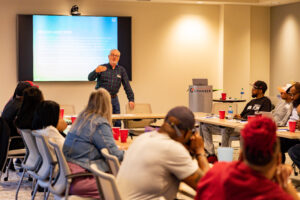Christina Siebold, Q Strategies
fL2XegcVhQg
“Information breeds confidence, silence breeds fear.” ~ fictional press secretary, CJ Cregg, The West Wing
As we adjust to the new normal of social distancing, working from home while homeschooling and cooking from the pantry (Alexa, what can I make with saltines, maple syrup and paprika?), our online lives have been overrun with coronavirus email updates from our favorite national and local businesses.
And every government agency with jurisdiction in the crisis.
And every nonprofit we ever followed on social media.
And that sandwich shop that gives you a free order on your birthday.
If you’re paid to support your company’s communications, this moment in time feels particularly fraught and urgent. You want and need to engage with your customers to ensure the survival of your organization, but what to say? And how best to deliver the message?
Here’s our five-step process for creating (or killing) corporate communications in the time of COVID-19:
1. What’s the point?
A clear message must be distilled before a comms staffer is sent to their computer to peck out an email to “all.” Is your industry in a hard-hit sector like health care, emergency services, grocery or pharmacy? Have your delivery mechanism or hours changed? Ensure the core message can be clearly articulated by leadership before signing on to another customer communication.
2. Lead with empathy
Regardless of your industry or position, COVID-19 has brought a level of uncertainty few have experienced. Uncertainty creates fear, and a myriad of negative emotions follow.
Research professor and Ted Talk star Brene Brown teaches that true connection – with clients, friends, customers and family – is often birthed through the practice of empathy.
- to see the world as others see it
- to be nonjudgmental
- to understand another person’s feelings, and to be able to communicate your understanding
How can you best express empathy for your customers in this moment? What is the nature of their concern? What is keeping them up at night? And how are you expressing your care for them in this moment?
“Like you, we are watching these developments with deep concern for our families and communities…”
“Normally in a crisis we gather, we hold a vigil, we hug. Now none of those things can be done, so we’re feeling a little lonely, and we know you might be as well.”
“Right now, we don’t have a perfect solution, but in times like these, we know that helping others is the right thing to do…”
A clear expression of empathy is the best way to lead any client communications effort. You don’t need all the answers. We don’t have them anyway. But we can show that we’re all in the same boat.
This is true, even if your business isn’t directly impacted by the crisis. Carrying on business as usual without acknowledging the very real concern and worry faced by your customers may leave your company looking out of touch and tone-deaf.
3. Declaration of values
From the Crisis Communications 101 vault, a statement of empathy must be connected to a declaration of values.
“Our highest priority is the safety of our team members and their families.”
“We value our deep relationships with our suppliers across the globe.”
“Our core concern is providing support services to our health care community during this challenging time.”
Your customers want to know the criteria you used to make the decisions you will be communicating. Connecting tactical decisions to clear and compelling core values is reassuring during a time of uncertainty.
4. Share the details; manage expectations
Once you have a clear message, you’ve led with empathy and shared your values, it’s time to give the details of your message.
- Changing hours
- Service delivery
- Temporary supply shortages
In sharing these tactical changes, it will be important to set the expectation that these details will likely change as conditions warrant.
For organizations hesitant to communicate during times of crisis, the common reason is the concern for rapidly changing information and their desire not to have to correct the record.
Every crisis presents rapidly changing environments and information flows. COVID-19 fits that pattern. Consumers generally understand that conditions can change, so setting that expectation is more of a reminder.
What consumers do not understand or forgive are organizations that had or should have had information that would have helped in a crisis, but who under-communicated for fear of changes.
5. Choose your channels
Our inboxes are full, but open rates hover under 15 percent. Social media is a quick and easy “solution,” but offers very few organic options for business profiles. Direct mail is expensive. Texts are immediate and have high open rates, but are inappropriate for regular communication.
Ensure that your message is consistent where people are already looking for you. That means a pop-up message on your website home page that links to a longer message on your blog. Social media should have clear updates in the 'about' section or bio. Space your emails apart and ask yourself if you are likely to have new information or a change of information in the next 24 hours. If the answer is yes, delay more direct communication such as emails and text messages.
As COVID-19 continues to present communications challenges, use this process to screen and then craft helpful engagement with your stakeholders.
Q Strategies is a full-service, strategic planning and communications firm located in downtown Chattanooga. With a collective experience of more than 75 years in strategic marketing and communications, we excel in strong community relationships that drive our success as we work with clients to tell their story and reach their goals.








